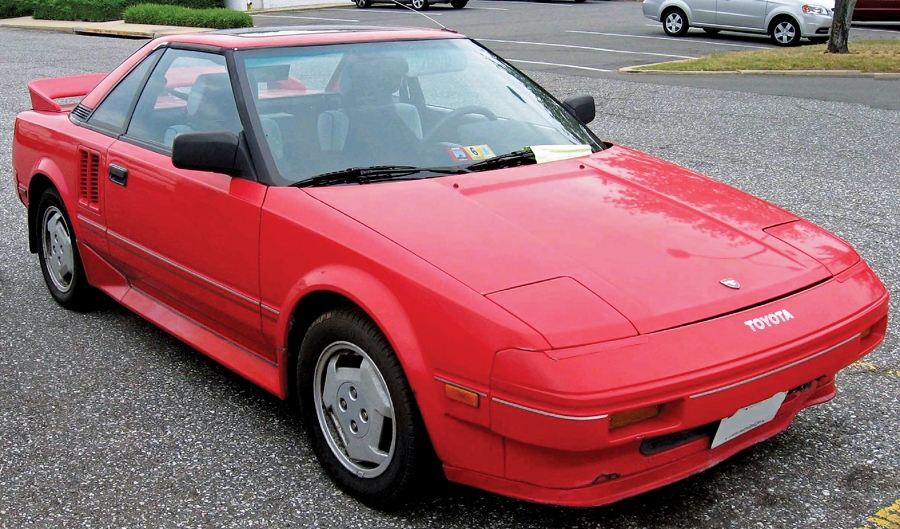Some marques, even in the affordable category, seem to engender passionate supporters. Mention Alfa or Porsche, and the swooning starts. Even the humble Miata has a plenty-of-fans.
The Toyota MR2? Not so much.
But if you are looking for an affordable two-seater, it should be on your list to investigate. They are plentiful and have performance on par with the competition — across nearly 25 years of production and three wildly different design envelopes.
The accidental sports car
The MR2 (apparently Toyota shorthand for Mid-engine, Rear-drive, 2-seater) was launched in 1984, but that belies a long development period, as Toyota started the process of creating a fuel-efficient two-seater (but not necessarily a sports car) way back in 1976. Toyota designers were looking for light, fun to drive and economical, and they settled on a mid-engine, rear-driver layout, which, as development proceeded, changed the focus more and more to building a sports car.
The MR2 went through three distinctive redesigns, with the first-gen W10 produced between 1984 and 1989. The second-gen W20 came along for the decade between 1989 and 1999. Finally, the W30 came along for the last tour, from 1999 to 2007.
For shorthand purposes, think of the three styles as kinda-Fiat X1/9, kinda Ferrari 348 and kinda Porsche Boxster.
You might also think “kinda derivative.” But, hey, it’s Toyota, and while the cars are technically strong, you have to go pretty deep in the canon to find something that stands out as a design exercise that gets the heart racing. Or, if it makes you happier, think, generally, but not exclusively, T-top to coupe to roadster.
All three were transverse mid-engine and rear drivers, mostly with 5-speeds, and all exhibited competitive handling and performance for the cars they were up against in the marketplace.
Hot and cold sales
Sales for the first-gen MR2 were more than adequate, with a peak of 51,271 leaving the factory in 1985 — but falling to a mere 13,153 by the end of the 1989 model year. Introduction of the second-generation car revived the brand briefly, with 45,424 built in the first year of production, but quickly falling below 20,000 units and finally bottoming out at only 3,309 in 1996. And the smaller, lighter, third-gen MR2 was an artistic success, but it was never able to pry open the wallets of buyers, with fewer than 30,000 sold throughout the run.
The competition for the MR2 obviously hasn’t changed. Options at this end of the market for cars of the same vintage are still primarily Miatas, Honda CRXs, and Fiat X1/9s. If you want to dig deep, and want to love “’Merica,” you can sample the Pontiac Fiero (if you must).
Also, you really have to choose the model and look that speaks to you. For me, it’s all about the first-generation cars. The second-gen Ferrari wannabe is a bit corporate and dull for my tastes, and the third-gen Boxster wannabe suffers from the same blandness that the Honda S2000 deals with — although on the positive side, it is pretty rare given the low sales volumes. But the first MR2 iteration was its own beast — an origami-ish wedge full of fun.
Reliable pep and handling
So, what do you get in a 1984–89 MR2? Start with the 16-valve, 1,587-cc 4-cylinder engine that was also in the Corolla of the period. The double-overhead-cam engine put out 112 horsepower, fuel-injected, and generated 0–60 mph times under nine seconds and quarter-mile times under 19 seconds. If you can find an MR2 Supercharged, the horsepower goes up 25% and cuts two seconds off the quarter-mile time.
Mostly what you get is enough performance enhanced by superb handling. The mid-engine layout, slightly rear-biased weight distribution and a stiff platform had the MR2, in period, doing quite well against most of the competition in car magazine comparison tests.
In fact, if you read the car rag reviews from the time, you will wonder why you didn’t rush out and buy one right then and there. Everyone was in love with the MR2; they were positively gushing. It was Car of the Year Japan, as well as Motor Trend Import of the Year, and it was consistently mentioned in top 10 lists.
That love was also true of owners, with reliability ratings off the charts, customer satisfaction as strong as the benchmark Honda CRX of the period, and a loyal customer base that thought the next car they would buy after the MR2 was another MR2.
On the downside, despite having both fore and aft luggage areas, there is little of it to use. Some complained about the looks, especially the height of the car, which made it appear like it was standing on tiptoes (on the other hand, that makes it much easier to get into and out of than the Miata).
Credit-card fun
Now the good news: These car are affordable — truly affordable. First-gen cars are plentiful enough, with many survivors. At the bottom end of the market, there are project cars for $500, while pristine supercharged cars will bring $10,000 — and plenty of well-loved 100,000-milers come along at that sweet spot in the middle. There doesn’t appear to be any auction market for them at this point, so think inexpensive fun rather than investment.
The bottom line might be to take a long look at the road less traveled, so stop scouring Craigslist for Miatas (which have become the darlings of newbie drifters, with a predictable rise in prices) and drive a few MR2s. If the motoring scribes loved them in the late 1980s, maybe you will as well. Just don’t forget your Milli Vanilli cassettes… ♦
